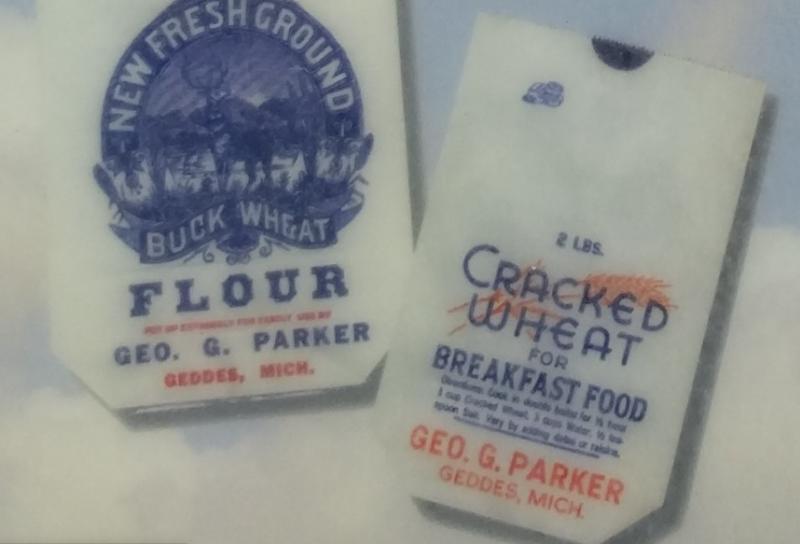…Porridge is ready
Delicious and ruddy
With pleasure, I relished
That my hunger has perished.
From Porridge Nursery Rhymes by international poet, Goodness Lanre, 2013
With whole grains at the forefront of our mission, it seems only fitting for the Bakehouse to delve into the world of porridge. And what a fascinating world it is!—with its long culinary history stretching back to the Agricultural Revolution of the Neolithic Era (between 8000 and 5000 BCE), and the countless variations of the hot, whole-grain cereal that people all around the world have been concocting ever since. Throughout history and within every culture, porridge has been a dietary staple. As one historian of early human history, Alistair Moffat, proclaimed a few years back, “The great invention, the greatest revolution in our history was the invention of farming. Farming changed the world because of the invention of porridge.”
For many around the world, porridge (also historically spelled porage, porrgie, parritich), represents nourishment: whole-grain goodness, healthy nutrition, and ultimate comfort, served up in a bowl. An added bonus is that it’s easy to make—simply boil or bake ground, crushed or chopped whole grains in water or milk. As food writer, Mary Luz Mejia, notes, “A big bowl of porridge can rev your internal motor at breakfast, help you unwind after a late night, or ease the previous night’s excesses. It can be made sweet, savory, thin or thick, with toppings or without. The only rules for entry into the ‘porridge club’ are that it needs to be made with a grain and it’s usually a dish best served warm to hot.”

The most humble and universal of dishes, porridge was our first and simplest way of cooking grains to release the arsenal of nutrition and burst of flavor locked inside. Grains, served up as porridge, fed our earliest civilizations and “sustained empires because they were powerhouses of nutrition, relatively quick to plant and harvest (unlike fruit and nut trees), easily stored in cold, drought, or rain, and capable of feeding armies,” so notes Rachel Laudan, author of Cuisine and Empire—a sweeping chronicle of the rise and fall of the world’s great cuisines. “The early Romans built their empire on barley porridge,” she says. In Asia, “the Chinese built theirs on rice porridge, the Indians on rice and lentil porridge.” The list of grain porridges throughout world history is prolific and global: in Scotland and Ireland, barley and oats; in America, oats, wheat, and corn grits; in Asia, rice; in Russia, the pseudograin, buckwheat; in Norway, rye; in Africa, millet, corn, and sorghum; in Italy, corn and millet polenta, to name but a few. Within the rich, diverse histories of food in every culture, almost everyone eats porridge; it has been and continues to be the everyday food of everyday people.
Wheat Porridge in the American Midwest – A Brief History
From babyhood to old age CREAM of WHEAT brings a smile of welcome.
Palatable, wholesome, nourishing, good at all times for all people.
Served in many tempting forms, — dainty breakfasts, delicious desserts.
CREAM of WHEAT CO., Minneapolis, Minn.
Cream of Wheat print advertisement, 1909
…When was the last time you cooked your old friend Cream of Wheat?
…Remember the mornings you woke up to a light new taste that lets the flavor shine through. It’s as good as you remember, Cream of Wheat
Nostalgic Cream of Wheat television commercial jingle, 1970s
Here in the United States, porridge has been a nation-wide breakfast staple since the late 19th century. Among the hot breakfast cereals to take America by storm in this period was farina, a form of milled wheat made from the germ and endosperm of the grain, which is milled to a fine consistency and then sifted. The porridge, branded Cream of Wheat® in 1893, was created by a group of enterprising millers based, initially, in Grand Forks, North Dakota and, eventually, in Minneapolis, Minnesota. Cream of Wheat started in a very small way, but with a sound idea and the vision and determination to build a successful and worthwhile business.
The story goes that Emery Mapes (b. 1853), a former newspaper publisher, printer and editor, decided in 1889, with his partner George Bull, a Grand Forks farm manager, to go into the milling business in Grand Forks by purchasing the milling machinery from the Diamond Flour Mill, after a fire destroyed the company’s milling facility near Mankato, Minnesota. Knowing nothing about the milling craft, the two partners hired Tom Amidon, an experienced miller, to supervise the operation of their facility as head miller.
As the Grand Forks Diamond Flour Mill struggled to find its footing in the dark days leading up to the Economic Panic of 1893, Amidon came up with the idea of producing for profit, a “breakfast porridge,” made from milled farina, the whitest part of the wheat, which he had taken home and cooked into a cereal for his family, much to their liking. The milling partners, Mapes and Bull, loved the porridge’s delicious taste and creamy smooth texture, prompting them to name it, “Cream of Wheat.”

Confident they were on to something, the partners then agreed to let Amidon pack some of the cereal and ship it to their New York brokers, Lamont Corliss & Company. With the milling company barely afloat, financially, at this time, Amidon was left to his own devices in preparing the cereal for shipment; he cut the cardboard for the cartons by hand, labeled the packages himself, and crated them in wooden boxes he made up from waste lumber. With no money to spend on package design, Mapes, a former printer, drew upon his stock of old printing plates for an appealing illustration to brighten up Amidon’s makeshift cereal cartons. The image he settled on, which he ended up creating himself, happened to be a figure of an African American chef holding a saucepan over his shoulder, the precursor to the present-day, widely-known Cream of Wheat trademark personage.
In October 1893, the Diamond Flour Mill sent 360 boxes of Cream of Wheat to New York, along with a carload of milled flour. Within 3 hours of the shipment’s arrival, the New York brokers sent a telegram to the Grand Forks mill stating, “Never mind shipping us your flour. Send us a carload of Cream of Wheat.” To fill this order of nearly 2000 boxes, and even larger shipments in the future, the Mill came up with a strategic plan that entailed renaming their enterprise the Cream of Wheat Factory and packaging the cereal in assembly-like fashion so as to maximize the number of boxes they could churn out daily. They also enlisted Melvin Brannon, a biology professor at the University of North Dakota, in developing an electrolysis treatment to eliminate contaminants and provide longer shelf life for the cereal.
1893 also saw Cream of Wheat making its manufacturing debut, to great popular fanfare, at the World’s Columbian Exposition in Chicago. To generate further national interest in their new cereal, not to mention market share, Mapes began running ads for Cream of Wheat in the Ladies Home Journal in November of 1896, promoting an image of wholesomeness, family, home, and security; this message, published as illustrated print ads in scores of national magazines, went on to become one of the most successful and transformative cereal advertising and marketing campaigns of the early 20th Century. The demand for the new cereal was extraordinary, so much so, that by 1897 it had outgrown the producing capacity of the small plant in Grand Forks. The company thus relocated the Cream of Wheat Factory to Minneapolis, which had become a major grain hub and distribution center for the growing cereal market. Cream of Wheat had arrived, giving oatmeal a run for its money as America’s favorite hot breakfast porridge!
Wheat Porridge – Some Local Michigan History
On a more local note, a perusal of the Ypsilanti Daily Press in August 1909 reveals that the Ypsilanti Milling Company, located on Cross Street along the east side of the Huron River, sought to tap into the extraordinary success and popularity of Cream of Wheat with their own take on the creamy wheat porridge, which they branded as Wheat Hearts.
To promote the venture, which ended up being very short-lived, the flour mill ran the following advertisement in daily issues of the paper over the course of a week in August 1909 (August 9-16), never to be seen again:

Around the same time that the Ypsilanti Milling Company was pitching their Wheat Hearts, in the daily paper, George Parker, in Ann Arbor Township, was transforming his father’s 1873 stone grist mill on Fleming Creek, off Geddes Road, from a family farm-based operation into a commercial flour mill. Beginning in 1910, following his father’s death, George milled, packaged, and sold to area grocery stores pancake mix, graham flour, buckwheat flour, cornmeal, and cracked wheat breakfast cereal, similar to Cream of Wheat, all under the brand name, “Parker’s Fleming’s Creek Mills.” The wheat cereal was packaged in 2-pound bags that bore a printed illustration of a couple of sheaves of wheat as the backdrop for the insignia and preparation instructions:

George continued to run the mill as a commercial enterprise until his death in 1956, at which point his son, Fred Parker, and other family members took over, but only for a few more years. By 1960, the mill had ceased operation and was sold, along with the family farm and other buildings on the property to the Frederick Mattael family. In 1983, the Washtenaw County Parks and Recreation Commission purchased the Parker Mill property and restored the mill back into full operation as the primary feature of Parker Mill Park, which opened to the public in 1984 and is still running to this day.

Now that we’re milling some of our own wheat at the Bakehouse on our stone mill, we decided to try freshly milled whole grain (FMWG) cream of wheat. It’s as comforting as the red box version and more flavorful because it contains the entire wheat berry. We are using coarsely milled, soft white wheat from Ferris Organic Farm in Eaton Rapids, MI and cooking it with local Guernsey Dairy milk. Come in and try some—it’s delicious with toppings or just on its own. But if embellishment is your thing, we currently have on hand Michigan dried cherries, California walnuts, Michigan maple syrup, muscovado brown sugar, milk, and cream to top your creamy whole wheat porridge.
Watch for new porridges and more porridge history in the coming months.
By Lee Vedder, Bakehouse Historian
Cream of Wheat photo via their Instagram, Wheat Hearts ad via YpsiNews.com, Geo. G. Parker packaging via HMdb.org
After a long, established career as a Ph.D. art history scholar and art museum curator, Lee, a Michigan native, came to the Bakehouse in 2017 eager to pursue her passion for artisanal baking and to apply her love of history, research, writing, and editing in a new exciting arena. Her first turn at the Bakehouse was as a day pastry baker. She then moved on to retail sales in the Bakeshop, followed by joining the Marketing Team and becoming the Bakehouse’s designated culinary historian. In addition to her retail sales and marketing work, she’s a member of the Bakehouse’s Grain Commission, co-author and editor of the Bakehouse's series of cookbooklets, and a regular contributor to the BAKE! Blog and Zingerman’s Newsletter, where she explores the culinary, cultural, and social history and evolution of the Bakehouse’s artisan baked goods.



